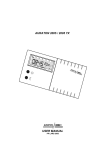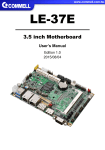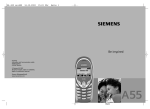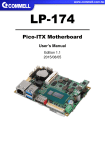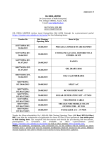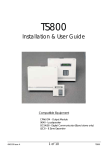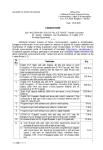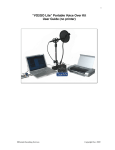Download Ambit Review 1 - Draft 1
Transcript
AMBIT WWW Ph: + 613 9598 7888 ete s Review Part 1 Tu ne dA thl Initial Overview - Peter (chilli) Mullins - Technical Manager - Highly Tuned Athletes. The aim of this series of reviews by Highly Tuned Athletes is to get accurate first hand information out to our customers based on real world user experience. We are aiming at 3 parts to the Ambit review. Please note at the time of writing, Part 1 was based on a prerelease model, the Ambit was also not supported at the time by Suunto Movescount. Part 1 : Initial Overview of the Suunto Ambit. Part 2 : Practical usage and user experience. Part 3 : Real world comparison to the Garmin FR910, Polar RCX5, Motorola ACTV. Hi gh ly First Impressions: One canʼt help but be blown away by the build quality of this watch. Just a quick flip to the back reveals the “MADE IN FINLAND” stamp, which of late has only appeared on the high -end Suunto Elementum series, most other current Suunto models having the standard “Designed in Finland - made in China” offering. The “Water resistant 100M” mark also another giveaway to the sturdiness of the design. 1 ete s The watch body, face, and mineral crystal lens are built to precision, no nasty surface overlap or plastic dags to be found here, the 4 Torx screws clamping the Ambit together yield a high level of confidence that this adventure watch is not going to fall apart no matter the conditions. The hardened rubber wrist strap looks and feels tough, the great thing over the previous Suunto X-10 though is that the band is replaceable, once again secured by 4 robust Torx screws. The dot pitch on the display is superfine, which is easy on the eyes and fantastic for displaying data such as heart rate or elevation graphs. Tu ne dA thl What may appear slightly odd to some, is the harder plastic section on the lower side of the watch body which the band hugs. For those unfamiliar with GPS integrated watches, this hardened “protuberance” in fact houses the ceramic patch GPS antenna also used by other manufacturers such as Garmin. No matter if you are left or right handed the antenna will face skyward on the wrist. The buttons on the Ambit are brilliant. There is a nice springiness and positive feel to each, reinforced by a nice loud beep on each depression of about 1 mm. ly Once again that feeling of quality is noticeable. The operation of the buttons can also be locked out to avoid accidental depression during an activity which is more than useful in the thick of action. The serrations on each also ensure positive positioning and feel, no matter whether pressed with bare skin or gloves. gh We took the opportunity to pressure test the Ambit to 100mtrs, before we had some real fun outdoors. Hi Passed with flying colours, not that we doubted the build quality or published specifications. 2 thl ete s Regarding size, lets face it the Ambit is not going to suit everyone. It is still a large watch, aimed with the outdoor sports adventure market in mind. Tu ne dA Suunto X-10, Ambit, Core, Quest. Hi gh ly Garmin FR610, Ambit, FR910. 3 ete s It is all about compromise with integrated GPS watches - battery life / capacity, readability, functionality, robustness, usability, and reliability, to name a few. We all want the ultimate tool that will provide metrics on everything we do, all the time that will not hinder our progress nor performance. The GPS satellite system is one way to obtain metrics such as speed, pace, distance, elevation, precise time of day, positioning and navigational information in the form of latitude and longitude, and sunrise/ sunset times, anywhere on the globe. GPS receivers need power, lots of it compared to other existing measurement techniques such as pods. thl To determine precise positioning you basically need a supercomputer of old on your wrist performing a massive number of calculations per second based on information received by up to 24 satellites orbiting the earth. The higher the sample rate for more precise tracking, the greater the number of calculations and higher the power consumption, thus less battery life. Tu ne dA As battery technologies advance, integrated GPS watches have reduced in size, however batteries still take up the vast proportion of space inside units such as the Ambit. It is a very big ask in producing a GPS based unit esthetically small enough and also to be able to provide sufficient power for its intended use. Suunto like Garmin have now moved to the latest high sensitivity GPS chipset available for portable mobile devices, that being the SiRFstarIV. Hi gh ly So having said all that, and if you are still with me, then what I am trying to point out is that if you have a very skinny wrist then the Ambit may not suit. As a runner I have a narrow wrist for a guy at 17cm, but the unit still felt comfortable although slightly larger than what I am used to. In the photo on the right the Ambit is being worn on a 14cm female wrist. My only concern was that the antenna tended to stick out a bit if tightened up a notch, and the excess strap could catch on tough trail if not tucked under the clasp. I will test over the next couple of weeks and all will be revealed in the Ambit review part 2. 4 Tu ne dA thl ete s The battery itself inside the Suunto Ambit is a rechargeable lithium-ion unit. The Ambit uses the same 4pin USB charging / data transfer clip as the older X-10 GPS unit, and slightly wider than the 3 pin T6 cable. 2 pins for charging and 2 for data. At this stage it is not clear whether Ant+ wireless transfers via the Suunto Movestick are possible, maybe a later option, but at this stage it seems as if cable is the only method. The Ambit will be both Mac and PC compatible via the Movescount software and web interface, ideally I would love to see local raw data file access from the Ambit itself without having to upload via the web, but not yet available, another item on my wish list. One of the stated features of the new Ambit is to be able to set the GPS sample rate, this in turn will effect battery discharge rates. For example if one was bushwalking or on a multiday hike, the sample rate could be set to once a minute to give 50hrs of recording. Alternatively for an event such as a trail run, 1 second recording could be enabled to give more precise recording and instant feedback, this mode will however reduce recording/ battery time to 15 hours. Lastly watch mode can be selected which will not use the GPS but still allow usage of the barometric Altimeter and digital 3D compass, battery life will be extended to 30 days between charging. The Altimeter is also apparently selectable between a 1 and 10 second sample rate. Unfortunately in the pre-production test unit we had, we could not adjust the sampling rates on either GPS or Altimeter. ly Dimensions: The Ambit measures up with a 50mm diameter (Silver), with a body depth of 18.2 mm. gh On the scales, the Silver Ambit weighed in at 81.6gms, slightly heavier than the 78gms in the published Suunto specifications. Hi An Ambit Black was not available for testing at the time of writing Part 1 of this review. 5 Tu ne dA thl ete s Operation: The Ambit is fairly simple to use, much of the basic ABC (Altimeter, Barometer, Compass) behaviour being based on that of the proven Suunto Core. The most frequently used button, the “Next” button cycles between the time screen, altimeter/barometer, and compass, by default . It is also used as a select function during various menu options. Hi gh ly The Altimeter/Barometer can be set to automatically switch modes, so changes in altitude arenʼt misinterpreted as weather changes and visa versa when stationary. Altitude references and sea level pressure can be set just like with the Core. Currently there is no depth meter display on the Ambit. The 3D Compass comes from Elementum heritage. 6 ete s If the “Next” button is held in for 2 seconds the Ambit will enter “Settings” mode, similar to the Core series. Settings from user weight, Alto/Baro functions, to pairing of devices such as the Heart Rate Monitor strap can be preformed via the various menus. Tu ne dA thl It did seem odd though with a GPS based watch that there was a Time/Date setting, sure it would come in handy if you never used GPS, but then what would be the point of using an Ambit. Even more complexing was the fact that only minutes and hours could be set ? During the course of testing with GPS on, there seemed to be no syncronization at all between the manual time setting and GPS based Zulu (GMT) time. One of the advantages of using a GPS time source is that you virtually have atomic clock accuracy on your wrist. When the battery did eventually flatten during testing, time and date settings were lost which was a worry. I will point out once again that we were testing a pre-release model, so final product could well and truly vary, we do hope so ! Just on the other buttons, the “Back/Lap” button allows you to back out of the menus, takes a bit to get used to if you are familiar with other watches such as the Core using the lower left button to back out. The other use for this button is to manually set a “lap split” during an activity. The “View” button provides the function of switching the lower data field on the display. For example the day of the week, seconds, and dual time zone, can be rotated through on the “Time” screen. The button also works on other screens such as the Altimeter and Exercise screens to show extra metrics such as temperature and averages. Hi gh ly Holding in the “View” button for 2 seconds will invert the display, then back again if held in for another 2 seconds. The inverted display does look more aesthetically appealing on the Black Ambit, but great to have the option on either model to be able to switch at any time. The inverted display is also easy to read at night with the backlight. 7 Tu ne dA thl ete s The “Light/Lock” button functions exactly as per its name. One press will activate the backlight which is actually nice and bright for a change for a Suunto product. Configuration of the backlight behaviour can be set under the “General” settings in order to conserve battery life if required. Holding the “Light/Lock” button for 2 seconds will also lock or unlock the Ambit, meaning that any accidental knocking of a button during an event will not be acknowledged. Finally the “Start/Stop” button. This is where it all happens. Pressing the “Start/Stop” button will take you 3 menu options, Navigation, Exercise, and Previous Exercise. “Previous Exercise” will show summary information for the last activity, unfortunately this seems to function similarly to the Quest operation and will only show the last immediate activity, ie. no built up history or totals on the Ambit itself, nor does there appear to be an option for deleting the last activity, a bit disappointing, maybe things will change on final release ? ly The “Exercise” screen allows you to select your activity type, which in turn configures the screen display values and graphs accordingly. At this point the Ambit will search for paired devices such as Bike Pods, a HRM, and look for a GPS signal. Hi gh The 4 default menu options available are; Trekking, Mountain Biking, Mountaineering, and Trail Running. The 4 options are basically profiles, which are customisable using Movescount, Suuntoʼs online software. At the time of testing Movescount had no support for the Ambit, which meant we were stuck with the default profile configurations. I can imagine the lack of ability to change screen attributes without a computer and web access to be a hindrance in the real world, maybe the 4 preconfigurable profiles will be enough ? Stay tuned to Part 2 of the review to see our verdict. We have also heard recently that more than 4 exercise profiles will be configurable once Movescount support is available in the near future. 8 ete s On selecting an “Exercise” type, the Ambit will initially search for pre-paired devices, configured under the General settings “Pair” menu. To be honest pairing the Dual Comfort HRM strap with the Ambit with the new “hold belt next to device” message, was the easiest experience with pairing a Suunto and HRM to date. And yes the standard Dual Belt worked with the Ambit, at least on our test unit it did ! Hi gh ly Tu ne dA thl After searching for known accessories, the Ambit will then try and obtain a GPS lock. A view to at least 4 satellites (8-9 overhead) are required to be able to calculate latitude, longitude and elevation. Suunto like Garmin, are using the latest SiRFstarIV chipset. Like the latest Garmin releases, the Ambit will also predict satellite orbit information (ephemeris) up to 7 days out from last use, which means faster acquisition times at the start of an activity. We put this to the test in Part 2 of our review. All I will say at this stage with our limited testing is that lock times were on par with other recently released units. We did observe some unexpected drop outs during testing where we couldnʼt get a lock again. We did also on occasion see the “GPS found” status hit 100% instantly when we were indoors with no GPS signal, most likely reading information from the internal cache. The giveaway was the absence of the little strength indicator at the 12 oʼclock position on the screen. I will add that I did find the lack of detailed GPS signal strength information and feedback to the user frustrating during testing, maybe an area to be improved upon, but will also wait for final product to be released to put the Ambit GPS to the real test. After the GPS found screen was either shown or bypassed by pressing the start/stop button, the display would then show the first of 3 screens of the “Exercise” profile selected previously. The “Next” button will cycle between the 3 data screens, the start/stop button starting, pausing, or stopping the session. “View” will also rotate additional metrics on the bottom row of the screen, selectable by the user in Movescount. 9 The 4 default “Exercise” screens and their standard offerings, normally configurable through Movescount, the Suunto Web based training portal: ete s Mountain Biking S1 - Time, Heart Rate, Altitude. (View - HR Avg). S2 - Time of Day, Speed, Distance. (View - Avg Speed). Tu ne dA thl S3 - Heart Rate, HR Graph, Time. Mountaineering S1 - Time of Day, Altitude, Time. (View - Temp). S2 - Time of Day, Distance, Average Speed. Hi gh ly S3 - Altitude, Altitude Graph, Time. 10 Unfortunately profiles canʼt be switched without completely stopping a session and starting all over, so some forward planning is required to what metrics will be most useful. ete s Trail Running S1 - Distance, Pace, Altitude. (View - Avg. Pace). S2 - Average HR, Heart Rate, Time. (View - Time of Day). Tu ne dA thl S3 - Heart Rate, HR Graph, Time. Trekking S1 - Time of Day, Distance, Time. (View - Avg Speed) ly S2 - HR Average, Heart Rate, Time. Hi gh S3 - Altitude, Altitude Graph, Time. 11 ete s During an activity, holding the “Next” button down for 2 seconds will take you to the “Options” screen. Under the “Options” menu, HR limits can be turned on, we assume these are also configurable under Movescount, as there was only an on/off option present. A known elevation reference or sea level pressure can be entered under Alti-baro. The behavior of the Ambit to record altitude changes (calculated from pressure readings) or pressure changes can be set under the Alti-baro Profile option. Lastly the Navigation menu option can also be accessed via this method which is discussed below. thl Pressing the Start/Stop button will pause an Exercise activity, holding the button in for 2 seconds will stop the activity and save to memory. When the activity is paused, pressing the “Back/Lap” button will also prompt if you wish to stop or continue the activity, it will then check whether you would like to save or not on stopping. Once an activity is saved, summary data is displayed with useful information such as Distance, Time, Laps, Total ascent/descent, Avg Speed etc. Summary information can also be viewed under “Previous Exercise”, but at the time of writing only the most recent activity can be viewed. Tu ne dA “Navigation”, is the last of the 3 options when the start/stop button is initially pressed. The “Navigation” option can either report a users current location as a latitude and longitude value (and be saved), or provide a bearing and distance measurement to a previously saved location called a waypoint. 100 Waypoints can be saved on the Suunto Ambit. In addition to being able to navigate to previously saved locations, we believe Waypoints can also be uploaded to the Ambit via Movescount. There was currently no option on the Ambit to manually enter a Latitude/Longitude value for navigation out in the field, which I found disappointing. Although the Ambit uses the 3D compass (works at any angle) in ABC watch mode, the “Navigation” menu option primarily uses GPS to guide the user to a previously saved waypoint, the compass also comes into play as well. The guidance is currently as the crow flies, no ability as yet to follow a course or breadcrumb trail. Hi gh ly Viewing and saving a location under the Navigation menu: 12 ete s Tu ne dA thl Under the Navigation / Waypoint menu, saved locations are listed by date. They can be viewed as in Latitude/Longitude values, deleted, or navigated to, no ability to edit or manually add however. Hi gh ly When navigating to a way point it is a pretty simple process, the Ambit will obtain a satellite lock, calculate distance and a bearing based on current location, then all you need to do is follow the arrow, degrees to turn are also displayed on the lower display field. Once set to navigate, the bearing will be held even without GPS being on, although the distance information will no longer be updated, ie using the functionality of the compass only. Stay tuned for more information in Part 2. 13 ete s Well thatʼs it for part one, designed as an initial overview of Suuntoʼs first Heart Rate Monitor with integrated GPS. On first impressions build quality was excellent and I do think the Ambit has potential to give the guruʼs in GPS sport watches, Garmin a run for their money. Garmin have set a high bench mark to meet, but Iʼm sure it is not an unsurmountable challenge. Hi gh ly Tu ne dA thl Join us with Part 2 of the Highly Tuned Athletes review where we put the Ambit to the test, and see how it stacks up in adventure land. Showroom: 579 Hampton Street, Hampton, Victoria, Australia 3188, Ph: +613 9598 7888 www: http://www.highlytunedathletes.com.au email: [email protected] 14 15 ly gh Hi ete s thl Tu ne dA

















